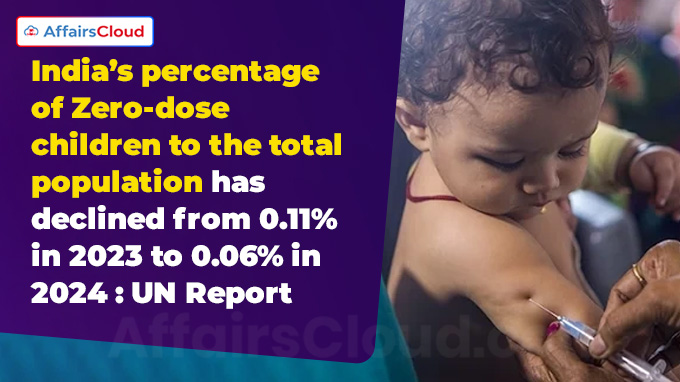 The United Nations Inter-Agency Group for Child Mortality Estimation (UN IGME) 2024 report revealed that the percentage of zero-dose children in India, those who have not received even a single vaccine, dropped from 0.11% in 2023 to 0.06% in 2024, establishing India as a global model in advancing child health.
The United Nations Inter-Agency Group for Child Mortality Estimation (UN IGME) 2024 report revealed that the percentage of zero-dose children in India, those who have not received even a single vaccine, dropped from 0.11% in 2023 to 0.06% in 2024, establishing India as a global model in advancing child health.
- This progress is mainly attributed by the continued and sustained efforts and intensified implementation of vaccination drives and campaigns across the country.
About UNIGME 2024 Report:
i.The report was released by the UN IGME, a collaborative initiative led by the United Nations Children’s Fund (UNICEF, headquartered in New York, the United States of America, ISA), the World Bank (Washington, D.C., the USA), and the UN Department of Economic and Social Affairs(DESA) – Population Division (New York, the USA).
- It publishes data of 195 countries in its ‘Levels and Trends in Child Mortality’ report annually.
ii.The world has achieved significant progress in lowering child mortality, with the global under-five mortality rate declining by 52% since the year 2000.
iii.The report showed the comparative results of countries on zero-dose children as a percentage of the total population such as: Yemen (1.68%), Sudan (1.45%), Angola (1.1%), Afghanistan (1.1%), Nigeria (0.98%), Democratic Republic of Congo (DRC) (0.82%), Ethiopia (0.72%), Indonesia (0.23%), Pakistan (0.16%), have far more zero-dose children compared to India’s (0.11%) during 2023.
Note: According to a paper published by The Lancet revealed that India had the second-highest number of unvaccinated children in 2023, with 1.4 million children missing routine vaccinations—following Nigeria, which recorded 2.5 million. Globally, the total number of unvaccinated children stood at 15.7 million.
Declines in Mortality and Stillbirth Rates:
i.Citing the UN IGME 2024 Report, the Ministry of Health and Family Welfare(MoHFW) highlighted that India has achieved a 78% reduction in the Under-Five Mortality Rate (U5MR), surpassing the global average decline of 61%.
ii.Additionally, India’s Neonatal Mortality Rate (NMR) dropped by 70% between 1990 and 2023, compared to the global reduction of 54%. Between 2000 and 2023 alone, India recorded a 70% decrease in U5MR and a 61% decline in NMR.
iii.India reduced its stillbirth rate by 60.4% over the same period, significantly outpacing the global average decline of 37%.
Key Progress in Child Health:
i.Decrease in MMR: As per the United Nations Maternal Mortality Estimation Inter-Agency Group (UN-MMEIG 2000-2023), the MMR of India stands at 80 per lakh live births, which reflects an 86% decline compared to the global reduction of 48% since 1990.
ii.Increase in Vaccination Coverage: India’s Universal Immunization Programme (UIP) covers a comprehensive range of vaccines recommended by Geneva (Switzerland) based World Health Organisation (WHO).
- Till 2013, there were only 6 available vaccines in UIP.
- In 2014, MoH&FW introduced 6 new vaccines in the programme namely, Inactivated Polio-virus Vaccine, Rotavirus Vaccine (RVV), Pneumococcal Conjugate Vaccine (PCV), Measles-Rubella Vaccine, Adult Japanese Encephalitis(JE) Vaccine and Tetanus Diphtheria (Td)Vaccine.
- At present, 12 vaccine-preventable diseases are covered by India’s UIP.
Key Initiatives Taken by Indian :
i.Zero Dose Implementation Plan 2024: This drive covers 143 districts across 11 states of the country, with a high burden of children who have not received any immunization dose so far.
ii.Mission Indradhanush (Since 2014): Intensified in 2017 in collaboration with state governments.
- So far, 5.46 crore children and 1.32 crore pregnant women previously unreached or under-vaccinated have been vaccinated under this mission.
iii.Pulse Polio Campaigns: Since 2014, India has maintained polio-free status through National Immunization Days (NIDs) and Sub-National Immunization Days (SNIDs).
iv.Village Health and Nutrition Days (VHNDs): These days are organised regularly for immunization and outreach activities at the community level.
v.Multi-tiered Task Forces: These task forces were formed at state (State-Level Full Immunization, STFI), district (District-Level Full Immunization,DTFI) and block ( Block-Level Full Immunization, BTFI) level to ensure coordinated and effective implementation
vi.Regular IEC (Information, Education, Communication) Campaigns: These campaigns help to raise awareness and combat vaccine hesitancy.
Comparison of India’s Vaccination Coverage with Other Countries:
i.As per WHO and UNICEF Estimates of National Immunization Coverage (WUNEIC) Report 2023, the annual birth cohort in India which is 2.6 crore, exceeds the total population of various countries such as New Zealand, Australia, Finland, and Switzerland.
ii.The report considered the fact that countries across the world vary in their sizes, thus, the percentage comparison shows it at par with the vaccination coverage levels observed in various high-income countries for instance: New Zealand (Diphtheria Tetanus Toxoid and Pertussis, DTP-93%), Germany & Finland (DPT-3 91%), Sweden (MCV-1 93%), Luxembourg (MCV-2 90%), among others.
iii.The report further revealed that India with high population size and socio-geographical diversity, National DTP-1 (Penta-1) has a coverage of 93% which means 2.47 crore out of 2.65 crore infants have been vaccinated even though during equivalent period which is much higher than Nigeria’s 70%.
- There is a combined decrease in dropout percentage from Diphtheria, Tetanus, and Pertussis(DTP-1) to DTP-3 from 7% (in 2013) to 2% (in 2023).
- Also, coverage of measles increased from 83% (in 2013) to 93% (in 2023).
Recent Related News:
The Registrar General of India (RGI), under the Ministry of Home Affairs(MHA), released three reports for 2021: the Sample Registration System (SRS) Statistical Report 2021, the Vital Statistics of India Based on the Civil Registration System (CRS) 2021, and the Report on the Medical Certification of Cause of Death (MCCD) 2021.
- According to the 2021 SRS report, the Crude Death Rate (CDR), which measures the number of deaths per 1,000 people, rose to 7.5, marking 2021 as the deadliest year of the Covid-19 pandemic.
- Even the CRS, which counts only registered deaths, shows an increase of around 2 million deaths in 2021. While, the MCCD report counted 4,13,580 Covid-19 deaths in 2021 and 160,618 deaths in 2020.




